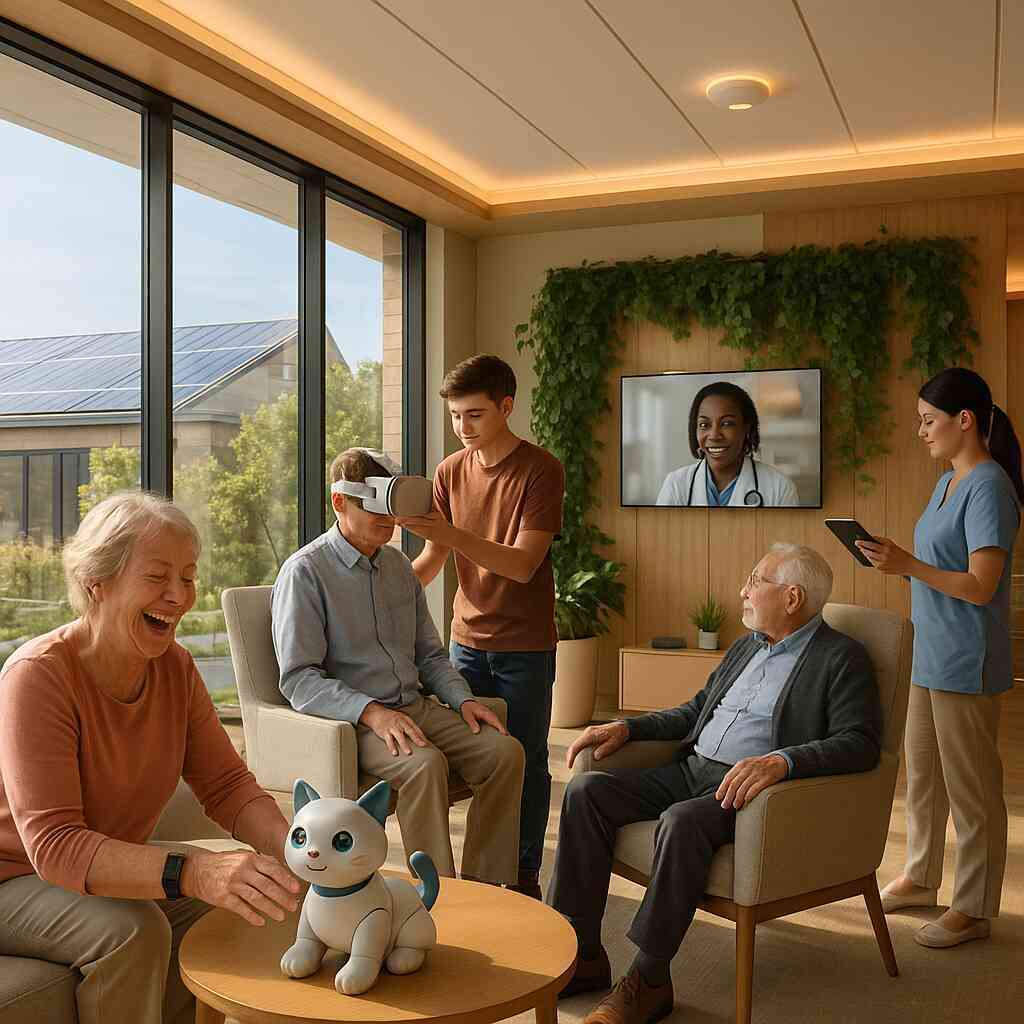
The Difference Between Nursing Homes and Assisted Living
August 17, 2024
Understanding Senior Care Spectrum
The Evolution of Senior Care
The landscape of senior care has evolved significantly over the years, transitioning from the one-size-fits-all approach of yesteryears to a more nuanced, individual-centric model today. This evolution reflects broader social and demographic changes, an improved understanding of senior health and wellness, and advancements in medical and assistive technologies. Historically, families either took it upon themselves to care for their elderly relatives or resorted to “old-age homes” when in-home care was no longer feasible. However, as life expectancy increased and family dynamics changed, a gap emerged in the care continuum. This gap led to the development of varied senior living options, each designed to cater to different levels of need, from minimal assistance to intensive, round-the-clock medical care.
Overview of Senior Living Options
The current spectrum of senior living options offers a diverse array of choices to meet the varying needs and preferences of today’s aging population, from independent living communities for those who seek a maintenance-free lifestyle with conveniences and social opportunities to assisted living facilities that provide personalized assistance with daily activities while still promoting independence. On the other hand, nursing homes cater to individuals who require 24-hour medical attention and support. This breadth of options ensures that older adults can find a living arrangement that aligns with their specific requirements, whether they prioritize social interaction, need help with day-to-day tasks, or require specialized healthcare support.
Identifying the Needs of the Elderly
Identifying the right type of senior living involves assessing the specific needs, preferences, and long-term care goals of the elderly individual. This assessment not only considers immediate needs, such as assistance with activities of daily living (ADLs) like bathing, dressing, and medication management, but also anticipates future healthcare needs. Factors such as the level of independence, cognitive and physical health status, and the desire for social engagement play critical roles in determining the most suitable living arrangement. By accurately identifying these needs, families can make informed decisions about whether an assisted living facility or a nursing home is the appropriate choice for their loved one, ensuring that the selected environment enhances their quality of life and meets their care expectations.
What is Assisted Living
Defining Assisted Living
Assisted living represents a unique blend in the spectrum of senior care, offering a marriage between independence and support. Designed for seniors who are generally active but require assistance with daily living activities, these communities present a lifestyle that fosters autonomy while ensuring help is at hand whenever it’s needed. Assisted living facilities are characterized by their personalized care services, which can range from basic assistance with medication management, bathing, and dressing to more comprehensive support based on the resident’s needs. This option stands as an intermediate level of care for those who do not need the intensive medical and nursing oversight found in nursing homes but seek more support than what independent living offers.
The Philosophy Behind Assisted Living
The foundational philosophy of assisted living centers on promoting the residents’ independence, dignity, and quality of life. This philosophy is actualized through a person-centered approach to care, which tailors services and activities to individual preferences and needs. By fostering a supportive environment, assisted living facilities aim to enable seniors to lead fulfilling lives, with the autonomy to make choices about their daily routines and the flexibility to adjust the levels of care as their needs change over time. This approach not only respects the individuality of each resident but also acknowledges their capabilities, encouraging active and engaged lifestyles.
Assisted Living Services and Amenities
Assisted living communities offer a wide range of services and amenities designed to enhance the living experience and meet the varied needs of their residents. These typically include meal preparation and dining services, housekeeping, laundry, and transportation services. In addition, many facilities provide wellness programs, fitness centers, social activities, and educational workshops to encourage a vibrant community life. Health and personal care services are personalized, with staff available 24/7 to assist with the specific daily living activities that residents need support with. The aim is to provide a safe, comfortable, and engaging environment that allows seniors to enjoy a high quality of life.
The Social Aspect of Assisted Living
One of the most significant benefits of assisted living is the emphasis on social engagement and community building. These facilities are designed to foster connections among residents through common areas, shared meals, and a wide variety of group activities. From exercise classes and art workshops to field trips and social events, the opportunities for interaction help combat the isolation often experienced by seniors living on their own. This active and communal lifestyle supports not only the physical health of the residents but also their mental and emotional well-being, contributing to a holistic sense of community and belonging.
What is a Nursing Home
Defining Nursing Home Care
Nursing homes stand as quintessential facilities for providing long-term care and medical services to individuals who require constant nursing care and have significant difficulty coping with the activities necessary for daily living. These facilities, often referred to as skilled nursing facilities, extend a higher degree of healthcare than what is available in an assisted living setting. Care in a nursing home is characterized by 24-hour monitoring and clinical support from licensed health professionals, including nurses, therapists, and aides, ensuring comprehensive medical oversight for residents with chronic health conditions, severe physical disabilities, or those in need of post-operative rehabilitation.
Long-Term Medical Care in Nursing Homes
The core mission of nursing homes is to offer long-term medical care that addresses both the immediate and ongoing health needs of residents. This includes not only routine medical monitoring and administration of medications but also access to specialized therapies such as physical, occupational, and speech therapy. Such facilities are equipped to manage complex healthcare requirements, offering services like wound care, intravenous therapy, and, in some cases, dialysis. The objective is to maintain or improve the health status of residents through a continuum of care, managing chronic conditions and reducing the need for hospitalization.
Nursing Home Amenities and Services
Beyond medical care, nursing homes strive to provide a comfortable and nurturing environment for their residents. Amenities typically include private or shared rooms, common areas for social interaction, landscaped outdoor spaces, and facilities for personal care needs. Services often extend to comprehensive rehab programs, dietary management catered by nutritionists, and various activities for daily living in senior communities that help maintain the physical and mental well-being of residents. Recreational and social activities are also scheduled to enrich the residents’ lives, offering opportunities for engagement and community interaction within the facility.
The Role of Nursing Homes in Elderly Care
Nursing homes play a pivotal role in the spectrum of elderly care, serving as a critical resource for individuals who require intensive medical supervision and assistance. They cater to a segment of the aging population that cannot be adequately supported through home care or in less intensive environments like assisted living facilities. By providing a combination of advanced medical care, rehabilitation services, and a supportive community, nursing homes aim to offer a sanctuary that values the dignity and individuality of each resident. They stand as an essential part of the healthcare system, ensuring that the elderly and others facing significant health challenges receive the care and support necessary for a dignified quality of life.
Comparing Assisted Living to Nursing Homes
When exploring senior living options, it’s critical to understand the specific needs and preferences of older adults to match them with the most appropriate care setting. Assisted living communities and nursing homes represent two distinct models within the spectrum of senior care, each designed to cater to different levels of health care, personal assistance, and lifestyle preferences. Below, we delve into the fundamental differences between these two options, focusing on levels of care, cost considerations, living environments, and the process of transitioning from one setting to another.
Levels of Care
The primary distinction between assisted living and nursing homes revolves around the level of care provided. Assisted living facilities are best suited for seniors who need some help with daily activities but do not require the intensive medical and nursing care that a nursing home provides. These communities offer support with activities such as bathing, dressing, meal preparation, and medication management, fostering independence with a safety net of assistance when needed.
On the other hand, nursing homes, or skilled nursing facilities, are designed for individuals who require around-the-clock nursing care and supervision. They cater to residents with serious health issues, those recovering from surgery or hospitalization, or individuals with chronic medical conditions that necessitate regular medical attention from licensed professionals.
Cost of Assisted Living vs Nursing Home
Comparing the cost of assisted living vs nursing home care is another critical factor for families to consider. Generally, nursing homes are more expensive due to the higher level of medical care and supervision provided. The cost difference stems from the staffing requirements, with nursing homes employing a larger number of licensed nurses and healthcare professionals. Assisted living, while still offering a broad range of services and amenities, typically has a lower monthly cost because the level of medical care required is not as extensive.
Living Environment: Assisted Living vs Nursing Home
The living environment between these two settings can significantly impact a senior’s quality of life and overall satisfaction with their care. Assisted living communities often resemble private apartments or homes, offering a more residential atmosphere. These facilities prioritize privacy, autonomy, and community engagement, with common areas for socializing, dining, and recreational activities.
Nursing homes strive to provide a comfortable and engaging environment, but due to the nature of care provided, they may have more of a clinical feel. Rooms might be shared, and the focus is on health stability and rehabilitation, which can sometimes limit opportunities for social interaction compared to assisted living settings.
Transitioning Between Assisted Living and Nursing Homes
Understanding when and how to transition between assisted living and nursing homes is crucial for ensuring that seniors receive the appropriate level of care as their needs change. Transitioning may become necessary when a resident in assisted living develops medical needs that can no longer be adequately met in that setting. Conversely, individuals in nursing homes may move to assisted living if their health improves significantly and they no longer require intensive care. This process involves careful assessment by healthcare professionals, in consultation with the individual and their family, to make decisions that best support the senior’s health, well-being, and preferences for their living environment.
Each of these transitions signifies a change in seniors’ care needs, underscoring the importance of choosing a senior care option that not only meets their current needs but also can adapt to future changes in their health and abilities. Senior Living Facilities provide resources and support to find senior living facilities nearby, simplifying the process of selecting the right care setting while considering these critical factors.
Benefits of Assisted Living
Promoting Independence and Socialization
Assisted living facilities provide an optimal blend of support and autonomy that encourages residents to lead vibrant, independent lives while having access to the care they require. One fundamental aspect of assisted living is its vibrant community setting, which actively fosters social interactions among residents. This environment helps seniors maintain a sense of individuality and freedom, with the added benefit of social activities and group events designed to nurture community bonds and friendships. Engaging in these social events significantly enhances the the quality of life in assisted living, helping seniors avoid the isolation that often comes with aging and promoting a fulfilling and socially active lifestyle.
Customized Care Plans
Assisted living stands out for its personalized approach to caregiving. Residents and their families work closely with care professionals to create a tailored care plan that considers the senior’s health needs, preferences, and independence level. This individualized strategy ensures that each resident receives the right amount of assistance with daily activities, medication management, and any other specific needs they might have. By prioritizing customization, assisted living facilities ensure that care is not a one-size-fits-all model but a dynamic service that adapts to the evolving needs of its residents, thereby supporting their well-being and autonomy.
Activities and Lifestyle
A cornerstone of assisted living is the focus on enhancing residents’ lifestyles through a wide range of activities and amenities. Facilities offer everything from fitness classes and art workshops to community outings and educational lectures, catering to the diverse interests and hobbies of their residents. This active engagement is crucial for mental and physical well-being, providing seniors with opportunities to learn new skills, pursue their interests, and engage with their peers. The emphasis on a rich and fulfilling lifestyle within these communities plays a significant role in promoting happiness and contentment among residents.
Safety and Security
Safety and security are paramount concerns in assisted living facilities, with comprehensive measures in place to ensure a worry-free environment for residents and their families. These might include 24/7 security personnel, emergency call systems in private living spaces, and on-site medical assistance. Moreover, the design of these facilities typically takes into account the mobility and accessibility needs of seniors, with features like handrails, non-slip flooring, and barrier-free layouts to prevent accidents. By prioritizing safety, assisted living communities provide peace of mind to both residents and their families, knowing that their loved ones are in a secure and caring environment.
The Role of Nursing Homes in Senior Care
Nursing homes serve an indispensable function in the continuum of senior care, providing specialized medical care and support for some of society’s most vulnerable members. These facilities are equipped to offer a comprehensive range of services that address the complex needs of individuals requiring constant medical attention, support for chronic health issues, rehabilitative services following surgeries or injuries, and compassionate end-of-life care. Understanding the multifaceted role of nursing homes is essential for families navigating long-term care options for their loved ones.
Providing Advanced Medical Care
At their core, nursing homes are designed to deliver advanced medical care to residents. This includes round-the-clock monitoring and treatment by licensed health professionals such as registered nurses, certified nursing assistants, and medical doctors. These facilities are equipped to manage a wide spectrum of health conditions, with the capability to administer IV medications, manage ventilator care, and provide complex wound dressings, among other services. The comprehensive nature of care available in nursing homes is particularly crucial for residents with conditions that require specialized medical knowledge and equipment, ensuring they receive the highest standard of healthcare.
Support for Chronic Health Issues
Chronic health issues, such as diabetes, heart disease, and dementia, require continuous management that goes beyond the capabilities of less intensive care environments. Nursing homes play a vital role in this regard, offering focused care plans that are tailored to manage and mitigate the symptoms of chronic conditions. Through personalized care strategies, residents receive not just medical treatments but also nutritional guidance, physical therapy, and cognitive exercises designed to improve their quality of life. This dedicated support helps stabilize residents’ health over the long term, reducing hospital readmissions and enabling them to lead as comfortable a life as possible.
Rehabilitation Services
Rehabilitation services are a key component of the support provided by nursing homes, aiding residents in recovering from surgeries, strokes, or other acute health events. These services often include physical, occupational, and speech therapy, each aimed at helping individuals regain independence and functionality. Skilled therapists work closely with residents, employing a variety of techniques and exercises tailored to address specific deficits. By focusing on restoring mobility, speech, and daily living skills, nursing homes play a crucial role in helping seniors achieve the highest possible level of autonomy and self-care.
End-of-Life Care
Nursing homes also provide compassionate end-of-life care, ensuring residents receive dignified support during their final days. This care extends beyond medical treatments to include emotional and spiritual support tailored to the residents and their family’s needs. Palliative care services focus on alleviating pain and symptoms associated with terminal illnesses, while hospice care offers a holistic approach that encompasses emotional and psychological support. By emphasizing comfort, dignity, and respect, nursing homes stand as a vital support system for families during profoundly challenging times, helping ease the transition at the end of life.
Nursing homes, with their comprehensive approach to care, are essential to the senior care spectrum. They offer medical, rehabilitative, and supportive services that are critical for those with extensive health care needs.
Choosing the Right Senior Care
Senior care is a diverse field, offering various levels of support and care to meet the unique needs of each individual. Selecting the most appropriate senior care option requires a careful assessment of personal needs, professional evaluations, and practical considerations about the future. In this process, understanding the difference between nursing homes and assisted living facilities is critical, as it helps in making an informed decision that enhances the quality of life for seniors.
Assessing Individual Needs and Preferences
The first step in choosing the right senior care is to assess the senior’s individual needs and preferences. This evaluation should consider both current and anticipated future needs, taking into account the senior’s physical health, cognitive abilities, and support requirements for daily living activities. Personal preferences relating to lifestyle, location, and the type of social environment desired also play a significant role in this determination. Seniors who are generally active but need help with daily tasks may find an assisted living facility more suited to their needs, offering a balance of independence and support. On the other hand, individuals with serious health issues requiring more comprehensive medical care might benefit more from the services provided in a nursing home.
Consulting with Healthcare Professionals
Seeking advice from healthcare professionals is an invaluable part of the decision-making process. Doctors, nurses, and geriatric care managers can offer insights into the senior’s health status, anticipated progression of any conditions, and the level of care required. These professionals can help families understand the benefits of assisted living versus the comprehensive care available in nursing homes. Consulting with healthcare professionals ensures that the chosen senior living option aligns with the medical and caregiving needs of the senior, thereby ensuring their safety, health, and well-being.
Visiting Senior Living Facilities
Before making a final decision, it’s essential to visit several senior living facilities to gain firsthand experience of the environment, culture, and the level of care provided. During visits, it’s critical to observe the demeanor of staff and residents, the cleanliness and safety of the premises, and the types of activities and amenities available. [Visiting senior living facilities](find senior living facilities nearby) firsthand helps families and seniors gauge whether the community meets their expectations and preferences. These visits also offer an opportunity to ask questions directly, discuss specific needs, and understand how the community addresses health and wellness.
Financial Planning for Senior Care
Financial planning is a crucial element in selecting the right senior care option. The cost of assisted living versus nursing home care can differ significantly, with nursing homes generally being more expensive due to the higher level of medical care they provide. Families should review their financial situation and and explore all potential funding sources, including long-term care insurance, veterans’ benefits, and Medicaid, where applicable. Understanding the economic implications and planning accordingly can help in choosing a senior living option that is not only suitable for the senior’s needs but is also sustainable in the long term.
Choosing the right senior care requires a multidimensional approach that combines personal needs assessment, professional consultations, firsthand observations, and sound financial planning. By carefully navigating these steps, families and seniors can make informed decisions that ensure the chosen senior living option provides a supportive, engaging, and fulfilling environment tailored to the senior’s needs.
Enhancing Quality of Life in Senior Living
Personalization of Care in Assisted Living and Nursing Homes
The cornerstone of enhancing quality of life in senior living environments is the personalization of care. In assisted living facilities, this means creating a care plan that adjusts to an individual’s daily needs while promoting maximum independence. It involves regular assessments to ensure that as a resident’s needs change, the level of care and support they receive evolves correspondingly. In nursing homes, personalized care extends to more detailed health monitoring and medical management, focusing on ensuring comfort, dignity, and respect for those with more intensive healthcare needs. The adoption of person-centered care practices in both settings guarantees that every individual feels valued and understood, positively impacting their overall well-being and satisfaction.
Community Engagement and Activities
A vibrant community life plays a vital role in enriching seniors’ lives, fostering a sense of belonging and purpose. Assisted living facilities excel in providing diverse activities that cater to various interests and abilities, from art classes and music sessions to fitness groups and social clubs. These activities are designed not only to entertain but also to encourage social interaction, mental stimulation, and physical activity. Nursing homes also offer community engagement opportunities tailored to the abilities and health conditions of their residents. These might include therapeutic activities, such as gentle exercise programs and reminiscence therapy, which support emotional and physical health. Engaging residents in these community activities greatly contributes to a positive and stimulating living environment.
Supportive Services for Families
Family involvement is crucial in enhancing the quality of life for seniors in assisted living and nursing homes. Recognizing this, many senior living facilities provide supportive services for families, including counseling, educational sessions about aging and health care, and regular updates on their loved one’s well-being. These services facilitate open communication between families and care providers, ensuring that everyone is aligned on the care objectives and the resident’s needs. Moreover, family support groups offered by many facilities can be instrumental in navigating the challenges of eldercare, providing a sense of community and mutual support among families experiencing similar journeys.
Adapting to Changing Needs Over Time
One of the most significant aspects of quality senior living is the facility’s capacity to adapt to the changing needs of its residents over time. This adaptability is crucial, as an individual’s health and abilities can evolve, necessitating different levels of care or services. In assisted living, this might mean increasing the frequency of personal care services or integrating more specialized health care monitoring. Conversely, a nursing home must be equipped to adjust the level of medical attention provided as a resident’s condition improves or declines. This flexibility ensures that residents receive care that is appropriate to their current situation, promoting their health, safety, and satisfaction continuously. Facilities that excel in this area often employ a multidisciplinary approach involving doctors, nurses, therapists, and other specialists to collaboratively adjust care plans collaboratively, ensuring they are always in the best interests of the resident.
By focusing on these key areas-personalized care, community engagement, family support, and adaptability-senior living facilities can significantly improve the quality of life for their residents. This holistic approach not only meets the physical and health care needs of seniors but also supports their emotional and social well-being, leading to a more fulfilling, enriching senior living experience.
Conclusion: Navigating Your Senior Living Options
Summarizing the Differences and Similarities
Choosing between assisted living and nursing homes requires understanding their primary differences and similarities to make an informed decision that best suits the senior’s needs. Assisted living facilities cater to individuals who require assistance with daily activities but still maintain a good level of independence. These communities emphasize social engagement, personal care plans, and a vibrant lifestyle with various amenities and activities. On the other hand, nursing homes offer long-term medical care for adults with serious health issues, providing 24-hour supervision and specialized healthcare services. Despite their differences, both types of senior living strive to enhance residents’ quality of life through personalized care, safety, and community-building activities. It’s crucial to find senior living facilities nearby that offer the right level of care, whether it’s the independence supported in assisted living or the comprehensive healthcare provided in a nursing home.
Making an Informed Decision
Choosing the right senior living option involves several steps, from assessing the senior’s individual needs and consulting with healthcare professionals to visiting facilities and planning finances. It’s essential to consider not only the current requirements but also future needs as health and abilities change over time. Resources like Senior Living Facilities can offer guidance through this process, helping families compare various options and connect with communities that meet their criteria. Whether prioritizing social lifestyle, medical care, or a specific combination of services and amenities, making an informed decision ensures the senior’s well-being and satisfaction with their living environment.
The Future of Senior Living
The landscape of senior living continues to evolve, shaped by demographic trends, technological advancements, and changing healthcare needs. Future senior living communities are anticipated to offer even more personalized care, incorporating technology to improve healthcare monitoring and enhance residents’ independence. Planned communities for seniors will likely emphasize lifestyle and wellness even more, integrating smart home technologies and virtual reality for social and entertainment purposes. As we look towards the future, the focus will increasingly be on creating environments that not only meet the comprehensive healthcare and daily living needs of seniors but also enrich their lives with meaningful connections and experiences.
Understanding and preparing for these changes is essential for families exploring senior living options. By staying informed about the latest trends and advancements, you can ensure that your chosen senior living solution will continue to meet your loved one’s needs now and in the future.
Navigating senior living options can be complex, but by focusing on the needs, preferences, and long-term happiness of seniors, families can find the perfect balance between care, comfort, and community.
Frequently Asked Questions
Question: What are the main differences between nursing homes and assisted living facilities?
Answer: The primary differences between nursing homes and assisted living facilities revolve around the level of care and medical services offered. Nursing homes, or skilled nursing facilities, provide 24-hour medical care and support for individuals with serious health issues, offering everything from routine medical monitoring to specialized therapies. Assisted living facilities cater to seniors who require assistance with daily activities but still maintain a higher level of independence. These communities emphasize social engagement and personalized care plans, with services that promote autonomy while ensuring help is available when needed. Senior Living Facilities is committed to helping families and individuals find the right care setting, whether you’re looking for the intensive medical care provided in nursing homes or the supportive living environment of assisted living.
Question: How can Senior Living Facilities help me find the best-assisted living options near me?
Answer: Senior Living Facilities simplifies the process of finding the perfect assisted living option near you. Our platform offers a comprehensive database of senior living communities in all 50 states, allowing you to search, compare, and connect with facilities that match your specific needs. Whether you’re looking for communities for seniors 55+ with vibrant social lives or assisted living locations that offer tailored care plans, our platform makes it easy. Please start by entering your area to discover nearby senior living facilities, then use our detailed comparisons to evaluate the level of care, activities, medical services, and more. Our skilled team is also available for personalized guidance, ensuring you make an informed decision that best suits your or your loved one’s needs.
Question: Can Senior Living Facilities provide information on both the cost and quality of assisted living vs nursing home care?
Answer: Absolutely! Senior Living Facilities offer detailed comparisons of both the cost and quality of care between assisted living and nursing homes. Understanding the financial and care considerations is crucial when choosing the right senior care option. Our platform enables you to assess the cost of assisted living vs nursing home care, considering the different levels of medical and supportive services provided. Additionally, we offer insights into the quality of life, amenities, and personalized care plans available in each setting, helping you weigh the benefits of each option. Our goal is to equip you with all the necessary information to find a senior living solution that fits your budget while fulfilling all care needs.
Question: In the blog ‘The Difference Between Nursing Homes and Assisted Living,’ it’s mentioned that transitioning between the two types of care may be necessary. How does Senior Living Facilities assist in this process?
Answer: Senior Living Facilities understand that the needs of seniors can change over time, making transitions between care levels a reality for many families. Our platform is designed to support families through these transitions, whether moving from assisted living to a nursing home or vice versa. We provide resources and guidance to evaluate when a transition might be needed, including professional assessments of health and care needs. By connecting you with a wide range of senior living options, we can help you find a new facility that meets the evolved care requirements. Our team offers personalized support every step of the way, ensuring the transition is as smooth and stress-free as possible for both the seniors and their families.
Question: What steps should I take to choose the right senior care for my family member through Senior Living Facilities?
Answer: Choosing the right senior care is a significant decision, and Senior Living Facilities is here to guide you through every step. Begin by assessing your family member’s needs, considering both their current situation and potential future care needs. Use our platform to search for senior living options in your desired location, from nursing homes for the elderly to assisted living plans. Compare the offerings of different communities, focusing on the levels of care, amenities, and lifestyle opportunities they provide. Don’t hesitate to connect with us for personalized guidance; our skilled team can answer questions, provide additional information, and help you arrange visits to prospective facilities. By taking these steps, you can make an informed decision that ensures a fulfilling and comfortable living environment for your family members.




